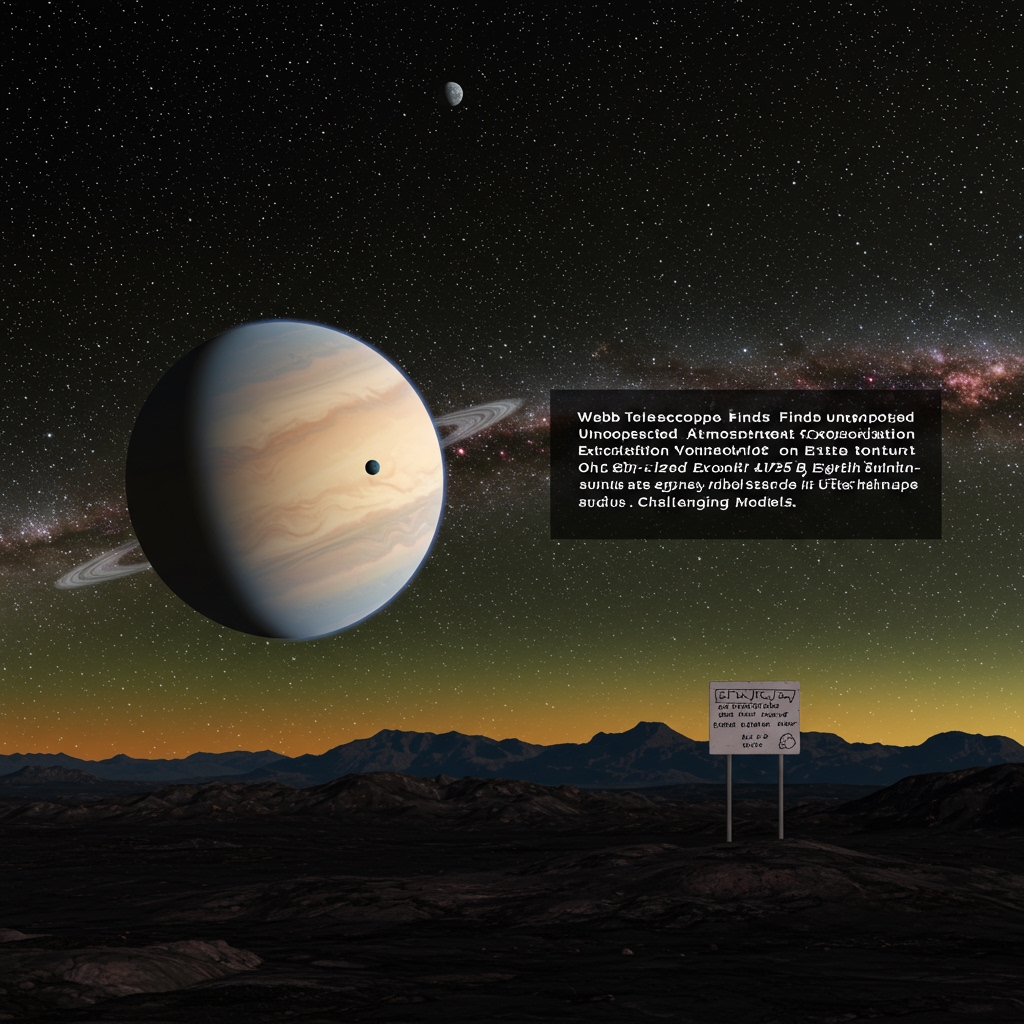Groundbreaking Discovery on Distant World
In a significant announcement made on January 29, 2025, scientists from the National Aeronautics and Space Administration (NASA) and the European Space Agency (ESA) revealed compelling findings from the James Webb Space Telescope (JWST) concerning the atmosphere of an exoplanet designated LHS 475 b. This Earth-sized world, located approximately 41 light-years away in the southern constellation Octans, has yielded data suggesting a surprising and previously unpredicted atmospheric makeup, presenting a fascinating challenge to current astrophysical models of rocky exoplanet atmospheres.
The James Webb Space Telescope, renowned for its unparalleled infrared observational capabilities, was tasked with observing LHS 475 b during its transit across the face of its host star. This method allows astronomers to analyze the light from the star that has filtered through the exoplanet’s atmosphere, revealing the chemical fingerprints of the gases present. The spectral analysis performed on the data collected from these transits provided the crucial information regarding the planet’s atmospheric composition.
Unpacking the LHS 475 b System
LHS 475 b orbits a red dwarf star. These stars, smaller and cooler than our Sun, are the most common type of star in the Milky Way galaxy. Planets orbiting red dwarfs are of particular interest to exoplanet researchers because many lie within the star’s habitable zone – the region where liquid water could potentially exist on a planet’s surface. LHS 475 b is categorized as an Earth-sized world, meaning its radius and mass are comparable to those of our home planet, making it a prime target for detailed atmospheric study, especially given its relative proximity at 41 light-years.
Red dwarf systems, however, present unique challenges for planetary habitability. These stars can be highly active, emitting powerful flares and high levels of ultraviolet and X-ray radiation, particularly in their youth. This intense radiation was theorized by some models to potentially strip away planetary atmospheres over time, especially for planets orbiting close to the star to receive enough heat – as is often the case for planets in the habitable zones of cooler red dwarfs. Therefore, understanding if and how planets in these environments retain atmospheres, and what those atmospheres are composed of, is a critical area of research.
The Webb Telescope’s Unexpected Findings
The spectral data from JWST’s observations of LHS 475 b delivered a result that diverged from typical expectations for such a planet. The analysis, while sensitive, revealed faint but distinct traces of a unique chemical signature. This signature was not consistent with either a completely absent atmosphere or with the compositions that some models predicted for a rocky planet orbiting a red dwarf at this distance. The precise nature of the detected chemicals was noted as surprising, indicating the presence of atmospheric components that current theoretical frameworks did not anticipate for this specific planetary context.
For context, analyzing exoplanet atmospheres is an exceedingly difficult task, particularly for smaller, rocky worlds like LHS 475 b. Most previously characterized exoplanet atmospheres belong to large gas giants, where the signal is much stronger. JWST’s capabilities have extended this possibility to smaller worlds, but the signals remain subtle. The detection of any distinct atmospheric signature on LHS 475 b is itself noteworthy, but the unexpected nature of the specific chemical fingerprint is what captured the attention of the scientific community.
Scientists had considered several possibilities prior to the Webb observations, ranging from LHS 475 b having no significant atmosphere at all, similar to Mercury, to possessing a thin atmosphere dominated by carbon dioxide, as seen on Venus, or perhaps a hydrogen-rich envelope if it formed further out and migrated inward. The detected signature, however, appears to point to a scenario different from these more commonly predicted outcomes for an Earth-sized planet around a red dwarf, particularly one subject to its star’s radiation.
Challenging Existing Atmospheric Models
The discovery of this unexpected atmospheric composition on LHS 475 b is significant because it directly tests and potentially challenges prevailing models of planetary formation and atmospheric evolution around red dwarf stars. These models are based on our understanding of physics, chemistry, and the conditions around different types of stars, extrapolated from observations of planets in our own solar system and the atmospheres of larger exoplanets. A finding that contradicts these predictions necessitates a re-evaluation of the underlying assumptions.
The presence of the unique signature suggests that either the initial atmospheric composition of planets forming around red dwarfs might be different than thought, or that the processes that modify these atmospheres over billions of years – such as stellar radiation, geological activity, or interactions with the stellar wind – operate in ways not fully captured by current models. It prompts fundamental questions: Where did these specific chemicals come from? How has the planet retained an atmosphere with this composition under the star’s influence? Are there planetary processes, perhaps geological or internal, that are replenishing or maintaining these atmospheric components?
Implications for Future Habitability Studies
This discovery provides critical, real-world data essential for refining the theoretical models used to understand and predict the atmospheres of rocky exoplanets, particularly those in red dwarf systems. Accurate atmospheric models are fundamental to the search for potentially habitable worlds and the future detection of biosignatures. If scientists don’t understand the ‘background’ atmospheric chemistry expected for a given planet type and stellar environment, identifying truly anomalous gases that could indicate life becomes significantly more difficult.
LHS 475 b serves as an invaluable case study, demonstrating that the atmospheric diversity of Earth-sized planets around red dwarfs may be greater than anticipated. Each new atmosphere characterized by JWST or future telescopes adds a crucial data point, helping to build a more accurate and complete picture of planetary populations beyond our solar system. This process of observation, model testing, and refinement is central to the scientific method and is propelling the field of exoplanetology forward.
The Path Ahead: Follow-Up Observations
Recognizing the preliminary nature of these groundbreaking findings and the need to confirm and further investigate the detected signature, the research teams have already scheduled follow-up observations of LHS 475 b. These additional observations are planned for later in 2025. With more observation time, astronomers hope to increase the signal-to-noise ratio in the spectral data, which could help to confirm the presence of the unique chemical signature with higher confidence and potentially allow for the identification of the specific molecules or elements responsible for it. These subsequent observations will be crucial for solidifying the initial findings and providing more detailed constraints for theoretical modelers.
In conclusion, the James Webb Space Telescope’s observation of exoplanet LHS 475 b has delivered a significant and unexpected result, revealing an atmospheric composition that challenges existing scientific understanding. This discovery highlights the power of JWST and underscores the vast diversity of planets that exist beyond our solar system, pushing the boundaries of our knowledge and setting the stage for even more exciting discoveries in the ongoing search for other worlds.





